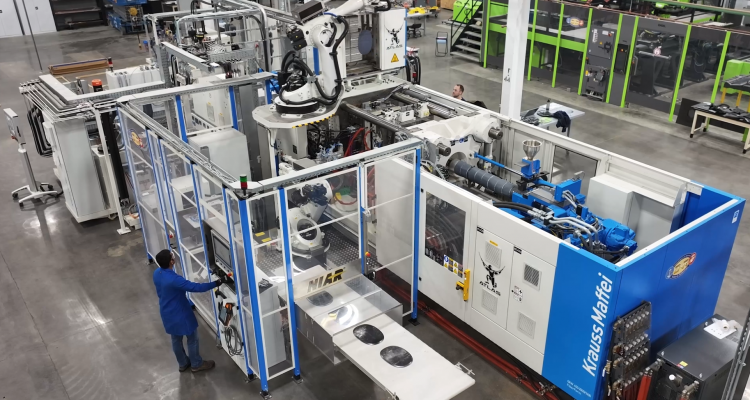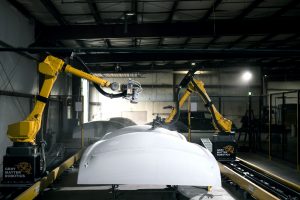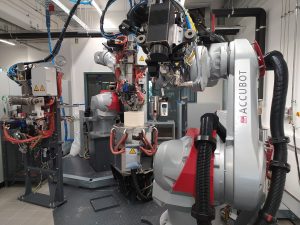There are nearly 26,000 aircraft in service worldwide, with aerospace OEMs anticipating more than 40,000 new passenger and cargo aircraft deliveries in the next 20 years. To meet that demand, current manufacturing rates will need to increase four to six times, according to Waruna Seneviratne, director of the Advanced Technologies Lab for Aerospace Systems at Wichita State University’s National Institute for Aviation Research (NIAR-ATLAS).
“Even with the most advanced automated equipment and technologies, it will be challenging to find enough trained technicians, engineers and designers to meet the high rates required by the aerospace industry,” says Seneviratne.
That’s where robotics come into play. A team at NIAR-ATLAS is working on a research project to demonstrate how technologies used for decades in high-rate automotive manufacturing could be used in aerospace. They are using hybrid overmolding to manufacture thermoplastic window plugs for cargo airplanes on a 450-ton Krauss Maffei injection molding machine equipped with two robotic cells.
“We can make a complete part every 90 seconds compared to two to three hours to machine the aluminum window plug it replaces,” says Senerviratne. And, thanks to automation and robotics, it only requires one person.
A Window of Opportunity
The thermoplastic window plug project represents a niche business in the aerospace industry – converting passenger planes into cargo haulers. Part of that process includes replacing acrylic windows with window plugs, currently made of aluminum.
Production of the demonstrator part at NIAR-ATLAS begins with flat, oval-shaped organosheets made from VICTREX AE™ 250 low-melt PAEK that are heated in an infrared oven, then placed in a mold and thermoformed into the shape of the window plug. Afterward, they are injection molded with a PEEK material including approximately 30% chopped fiber.
The operation relies on two robots working simultaneously. The first robot places the blank organosheet in the oven, removes it once it’s been heated and then puts it in the mold. After the overmolding is complete, the second robot removes the part from the mold and places it on a conveyor belt.
“While one robot pulls out the finished part, the other is transferring a new organosheet from a stack into the infrared oven,” says Seneviratne. “A bin at the end of the conveyor belt collects the finished parts that can then be picked up by a lab tech.”
Currently, the window plugs require surface preparation and painting. In the next phase of the project, NIAR-ATLAS hopes to add Krauss Maffei’s ColorForm technology to put polyurethane coating on the parts. The team is researching compatible materials.
In addition, the team is running thermal and mechanical testing on the thermoplastic window plugs to achieve FAA certification. When the certification paperwork is complete, Seneviratne is optimistic that the part will be integrated into the cargo plane conversion process. The advantages have caught the attention of aerospace OEMs.
“The thermoplastic window plug is 20% lighter than an aluminum one and faster and cheaper to produce,” he says. “While the mold is expensive, if you can make 40 parts in an hour – 300-plus parts a day – then you basically recover the entire cost of the mold within a few weeks.”
Applications Beyond Aerospace
While the ATLAS window plug project is a demonstrator, many commercial applications rely on robotics. One example is front doors for houses.
“Instead of using wooden doors, one of our customers in the building industry makes door panels from fiber-reinforced composites via long fiber injection,” says Marc Perberschlager, general manager of Fill USA Inc., a machine engineering company. “They use Krauss Maffei and Fill technology to produce them at a high rate.”
The manufacture of leaf springs for the Ford F-150 pickup truck also relies on robots to perform automated stack lay-up prior to high-pressure resin transfer molding.
“The robot stacks up the fiber layers and hands the stack over to the preform press, where it is consolidated under heat. Then the next robot takes the preform and puts it into the HP-RTM press, where the resin is injected,” says Perberschlager. “The leaf springs are also finished fully automatically using robots. Automation enables us to reduce the cycle time to less than one minute per part.”
Robotic cells are ideally suited to repetitive tasks, jobs that employees don’t want to do or work that presents safety hazards.
“Injection molders are using robotics to extract parts from machines, so people don’t have to handle them,” says Andrew Pokelwaldt, owner of consultancy AWALDT LLC, which offers automation training and education. “It’s dangerous and hot where the parts are coming out.”
GrayMatter Robotics built its business on providing automated solutions for tedious tasks. Its surface finishing and treatment robots perform sanding, polishing, buffing and grinding.
“People simply don’t want to do these tasks, and there is a lot of labor shortage in this area,” says Satyandra K. Gupta, co-founder and chief scientist at GrayMatter. “We needed to address this issue in the composites industry to avoid product delays and backlog.”
Among the challenges with automating these functions, however, are the high variability among parts and the need to avoid expensive custom fixtures to hold them. Gupta says GrayMatter’s robotic cells rapidly scan parts, then use automated planning software to build a model that ensures accurate placement and correct motion of the tool (grinder, sander, etc.). In addition, the system monitors the cell operation throughout the process to make sure it’s functioning properly.
“It provides complete traceability and quality assurance; therefore, you can produce higher quality products,” says Gupta.
Robotic Advancements
While robotic cells are well-suited for simple, repetitive tasks, suppliers continue to innovate.
Fill’s ACCUBOT multimodal robot system performs drilling, trimming and non-destructive testing. Perberschlager says the equipment can perform five-dimensional operations with an accuracy of 0.1 millimeters. The ACCUBOT is equipped with an automatic tool changer to easily shift between functions.
Fill collaborated with an aerospace OEM to develop a vibration assisted drill spindle that can control parameters such as chip formation, temperature and revolutions per minute on the fly to drill through composite structures and metal parts. The technology causes significantly less fiber damage and eliminates the deburring and inspection process, which saves time and tool costs in high-rate production, says Perberschlager.
“You don’t need to inspect the hole after drilling because the U.S. patented spindle acts as a sensor,” says Perberschlager. “If the real-time evaluated drilling parameters are off, the robot will flag that hole for inspection or even stop the operation to allow a human to assess the situation.”
Fill is currently teaming with Krauss Maffei on another project to create an additive manufacturing cell for fiber reinforced thermoplastics by placing an extruder on the ACCUBOT so customers can print, drill, trim and inspect a part in a single manufacturing cell.
“Customers will be able to do very efficient, rapid prototyping with one machine,” says Perberschlager. “This solution is ideal for companies that don’t require high rates.”
Solutions for Everyone
Multifaceted automated systems may be out of reach for small companies, but turnkey solutions open the world of robotics to companies of all sizes. Some vendors offer a monthly or yearly service, so companies don’t have to make a large upfront capital investment.
“Even a small company can use our solution and get all the benefits of robotics without worrying about having robotics expertise to make it work,” says Gupta.
As technology advances, equipment and software are also becoming more user-friendly.
“I am not somebody that thinks in code, but I can get on a Fanuc collaborative robot now and it’s basically like working on an Android tablet putting together a program. There are some standardized templates that you feed into it, and the code is in the background,” says Pokelwaldt. “Eventually, you will have line workers setting things up because it’s not that hard to do.”
Employees and robots working in tandem can improve productivity, leading to sought-after high rates in the aerospace industry. For instance, the two-sided ACCUBOT drilling cell allows employees to manually load and unload a wing flap from the fixture, while the ACCUBOT simultaneously performs precision drilling and counter sinking on the previously loaded fixture.
“With robots, you can significantly cut back on hours of repetitive manual labor and reduce the risk of human error. You can build a very reliable process and allocate manpower to more challenging topics,” says Perberschlager. “Automating standard procedures with robots paves the way toward high-rate manufacturing.”
Susan Keen Flynn is managing editor of Composites Manufacturing magazine. Email comments to sflynn@keenconcepts.net.
Will Robots Replace Workers?
Robotic cells are taking over jobs in manufacturing plants, but that doesn’t mean employees on the plant floor are becoming obsolete.
“People sometimes tell us, ‘Your robots will take our jobs away.’ But it’s quite the opposite,” asserts Waruna Seneviratne, director at the ATLAS Lab at Wichita State University’s National Institute for Aviation Research. He notes that aerospace manufacturers can boost production significantly using automated equipment and robots – and create opportunities for workers.
“Instead of making five parts a month, now I’m making 20 parts a month,” says Seneviratne. “People still need to add the necessary wiring and electronics, paint the parts and so on. Now I need to find four times more employees to do those jobs.”
Andrew Pokelwaldt, owner of consultancy AWALDT LLC, adds that strategic use of robotics can improve job satisfaction and retention by freeing up employees to work on more meaningful tasks.
“When your hourly employees aren’t burdened with repetitive tasks that bore them, they can move on to things that bring value to your business,” he says. “This gives them a chance to focus on continuous improvement processes, quality assurance and other important areas.”
The GrayMatter Scan&Sand™ system can sand a part up to four times faster than humans and catches more than 95% of sanding dust to enhance worker safety, according to the company.
Photo Credit: GrayMatter Robotics
Fill’s ACCUBOT (ACCUrate roBOT) system prints a fiber reinforced composite demonstrator part.
Photo Credit: Fill




